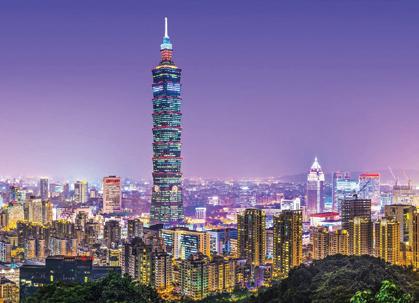
5 minute read
Outcompeting China: A Roadmap for the U.S
by CLARK PACKARD
It has become conventional wisdom around the into commercial networks, and massive industrial Beltway that the United States and China are on a subsidies. Together, the United States argues, these collision course — a new “cold war.” The new cold policies make it unfair and burdensome for American warriors on both sides of the aisle argue that trade and firms to compete in China. These are legitimate investment with China have enriched a brutal regime complaints, and a response from Washington was and made the United States much too vulnerable to necessary. the whims of Beijing. Though a flawed analogy, the Next, tariffs — the president’s preferred tool — chorus has grown louder as the are unlikely to fundamentally United States tries to control transform Beijing’s economic the outbreak of a pandemic that model and have hamstrung originated in China. It is clear the U.S. economy. Numerous that tensions between Beijing and economic studies confirm Washington are rising. But rather that American consumers, than decoupling the two largest not Chinese exporters, are economies in the world, there is paying the tariffs, despite the a smarter approach to confronting president’s repeated statements legitimate problems posed by to the contrary. Even after the China’s economic model. “Phase One” detente signed by
As a preliminary matter, it is the United States and China in important to note that China does January, the president’s tariffs engage in repressive human rights cover about $350 billion worth practices and has effectively of imports from China with annexed Hong Kong through its an average rate of almost 20 recently enacted national security Clark Packard percent, more than six times law. The United States should higher than when the trade war confront these policies with narrowly tailored sanctions and visas for Hong Kong residents. Rather than decoupling the two largest economies began. The tariffs have been costly; it is estimated the tariffs cost the typical household Broad-based trade, investment in the world, there is more than $830 in 2019 and and immigration restrictions are unlikely to improve China’s behavior while undermining the a smarter approach to confronting legitimate caused 300,000 job losses. In 2019, U.S. manufacturing slipped into a recession despite long-term competitiveness of the problems posed by a strong economy overall and United States. A nuanced understanding China’s economic model. the tariffs were partially to blame. Likewise, a recent study of the economic fault lines that estimates that the trade war with exist — beyond the president’s China cost American companies obsession with China’s bilateral up to $1.7 trillion in lost market trade surplus with the United capitalization. It belies common States — is imperative if Washington is going to sense to think that weakening ourselves with outdated outcompete Beijing. The crux of the United States’ tariffs will strengthen our position vis-a-vis China. complaints about China’s economic model revolve So if the United States has legitimate complaints around the abuse of intellectual property, the transfer of about Chinese trade practices but tariffs are unlikely to technology from American firms to Chinese firms as a change those practices, what should policymakers do? condition of doing business in China, cyber intrusions
In short, we need to outcompete China. wrangled with whether to restrict Huawei’s purchases
The United States made an egregious error when of American products. To the extent that policymakers it abandoned the Trans-Pacific Partnership (TPP). should restrict trade, it needs to be done on a While imperfect, TPP was designed to strengthen vital transparent, consistent and limited basis where there supply chains in the Asian Pacific region by offering is a genuine national security threat — not a pretext countries in China’s orbit an alternative market of for protectionism. approximately the same size—one based on the rule If the United States wants to continue its dominance of law with enforceable commitments, not based on of the commanding heights of technology, we need to sheer economic might. TPP also provided a worthwhile dramatically increase immigration. Immigrants are template for confronting more likely than natives to China with allies, rather apply for patents and start than unilateral tariffs. businesses; Google and
On top of the geostrategic Qualcomm, two cuttingbenefits, by cutting tariffs edge technology firms, were and ferreting out some nonfounded by immigrants. It tariff trade barriers on both is estimated that about half sides of the Pacific, TPP of all those employed in would have been a boon to Silicon Valley are foreignAmerican consumers and born — a staggering figure. producers. Families buying Meanwhile, between 30 consumer goods produced percent and 50 percent of in TPP countries would see productivity growth in the cost savings at the register. United States between 1990 Meanwhile, American The skyline of downtown Taipai. and 2010 was driven by firms would have seen foreign-born workers. expanded market access Unfortunately, the in a growing region and Rejoining TPP and expanding Trump Administration enhanced competitiveness from cheaper component parts and capital goods it to include Taiwan, a hub of high-tech manufacturing, and has severely restricted immigration. A new study found that legal immigration sourced from TPP countries. India, a massive country with will have declined by In other words, TPP was a positive-sum agreement that could have helped untapped potential, should be a top priority for policymakers about 50 percent since the president was inaugurated. Meanwhile, universities, raise commercial standards serious about the economic long an incubator of research in the region and lessened U.S. dependence on China. challenges posed by China. and development, have seen international enrollments Beijing was the single decline between 63 percent biggest beneficiary of the to 98 percent from 2018-19 Trump administration’s unforced error. Rejoining TPP levels, according to the same study. Over the long run, and expanding it to include Taiwan, a hub of highthis type of sclerotic immigration restrictionism will tech manufacturing, and India, a massive country dampen growth and competitiveness, particularly in with untapped potential, should be a top priority for technology. policymakers serious about the economic challenges Globalization — the movement of people, ideas, posed by China. capital, goods and services — across borders helped
In many respects, tariffs on unrelated products propel the United States to unprecedented wealth and are merely a manifestation of the larger competition influence. With a global pandemic and China rising, over technological supremacy in an increasingly policymakers are increasingly tempted to turn inward. interconnected world. Huawei is a perfect example. That would ensure the slow decline of U.S. prosperity Many policymakers in Washington believe the Chinese — and hasten China’s ascendency. Instead, openness to telecom giant is a national security risk to the United trade and immigration are necessary components of any States. For Xi Jingping and the Chinese government, policy to outcompete China in the 21st century. RF Huawei is the cutting-edge Chinese technology firm that could dominate the future of telecommunications Clark Packard is a resident fellow and trade policy networks. Over the last several years, Washington has counsel at the R Street Institute.











